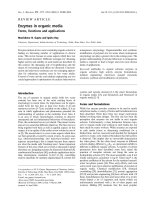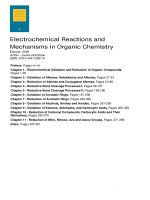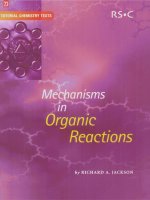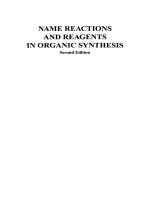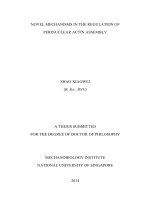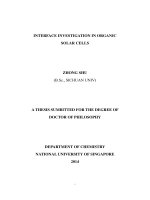Mechanisms in organic reaction RSC
Bạn đang xem bản rút gọn của tài liệu. Xem và tải ngay bản đầy đủ của tài liệu tại đây (17.65 MB, 210 trang )
Cover images
0
Murray Robertson/visual elements
1998-99,
taken from the
109
Visual Elements Periodic Table, available at
www.chemsoc.org/viselements
ISBN 0-85404-642-9
A
catalogue record for this book is available from the British Library
0
The Royal Society
of
Chemistry 2004
All rights reserved
Apart-from any fair dealing for the purposes
of
research or private study, or criticism or
reviews as permitted under the terms
of
the
UK
Copyright, Designs and Patents Act,
1988,
this publication may not be reproduced, stored or transmitted, in any form or
by
any means, without the prior permission in Ivriting
of
The Royal Society
of
Chemistry, or
in the case
of
reprographic reproduction only in accordance with the terms
of
the licences
issued by the Copyright Licensing Agency in the UK, or in accordance with the terms
of
the licences issued by the appropriate Reproduction Rights Organization outside the UK.
Enquiries concerning reproduction outside the terms stated here should be sent
to
The Royal Society
of
Chemistry at the address printed on this page.
Published by The Royal Society of Chemistry, Thomas Graham House, Science Park,
Milton Road, Cambridge CB4 OWF,
UK
Registered Charity
No.
207890
For further information see our web site at www.rsc.org
Typeset in Great Britain by Alden Bookset, Northampton
Printed and bound by Italy by Rotolito Lombarda
Preface
The wonderful complexity of organic chemistry involves thousands of
different reactions which allow the synthesis and interconversions of mil-
lions of compounds, some of great complexity. The key to understanding
this vital branch of chemistry is the concept of the reaction mechanism.
This book starts with a discussion of how covalent bonds break and
form, and how these bond-breaking and bond-forming processes pro-
vide the basis of reaction mechanisms. The principles governing how to
make sensible suggestions about possible mechanisms are set out, and the
distinction is made between elementary reactions, which involve just one
step, and stepwise reactions which have more than one step and involve
the production of intermediates that react further.
Chapter
2
covers kinetics, which provides useful information about react-
ion mechanisms, and allows us to distinguish between possible mecha-
nisms in many cases. Elementary reactions do not involve intermediates,
but
go
through a transition state. Although this transition state cannot be
isolated,
it
can be studied in various ways which provide insights into the
reaction mechanism, and this forms the subject matter of Chapter
3.
This is
followed by three chapters on the most important intermediates in organic
chemistry: anions, radicals and cations. A final chapter on molecular
reactions concerns thermal and photochemical processes. The concepts of
frontier orbitals and the aromatic transition state allow us to predict which
reactions are “allowed” and which are “forbidden”, and provide insights
into why most reactions of practical interest involve multi-step processes.
Where common names are used for organic compounds, the systematic
name
is
given as well at the first mention. Common names are widely used
in the chemical literature, in industry and commerce, and there is a great
divergence in the use of systematic as opposed to non-systematic nomen-
clature in the English-speaking world.
I
thank many colleagues for helpful comments and advice, particularly
Mr Martyn Berry and Professor Alwyn Davies
FRS
who have read the
entire manuscript and whose suggestions for changes have improved the
text in numerous places.
I
would also like to thank my wife Pat for her
support and forbearance over the past three years. Enjoy the book!
Richard
A.
Jackson
University
of
Sussex
iii
ED
IT0
R-1
N
-C
H
I
EF
EXECUTIVE EDITORS EDUCATIONAL CONSULTANT
Projessor
E
W
Abel Professor A G Duvies
Professor D Phillips
Prqfessor
J D Woollins
Mr
M
Berry
This series of books consists
of'
short, single-topic or modular texts, concentrating on the
fundamental areas of chemistry taught in undergraduate science courses. Each book provides a
concise account
of
the basic principles underlying a given subject, embodying an independent-
learning philosophy and including worked examples. The one topic, one
book
approach ensures
that the series is adaptable to chemistry courses across a variety of institutions.
TITLES
IN
THE SERIES TITLES IN THE SERIES
Stereochemistry
D
G
Morris
Reactions and Characterization
of
Solids
Main Group Chemistry W
Henderson
d- and f-Block Chemistry
C
J Jones
Structure and Bonding
J Burrett
Functional Group Chemistry
J
R
Hanson
Organotransition Metal Chemistry
A
F
Hill
Heterocyclic Chemistry
M
Sainsbury
Atomic Structure and Periodicity
J Barrett
Thermodynamics and Statistical Mechanics
Basic Atomic and Molecular Spectroscopy
Organic Synthetic Methods
J
R
Hanson
Aromatic Chemistry
J
D Hepworth,
D
R
Waving and
M
J Waring
Quantum Mechanics for Chemists
D
0
Hayward
Peptides and Proteins
S
Doonan
Biophysical Chemistry
A
Cooper
Natural Products: The Secondary
Metabolites
J
R
Hanson
Maths for Chemists, Volume I, Numbers,
Functions and Calculus
M
Cockett and
G
Doggett
Maths for Chemists, Volume
TI,
Power Series,
Complex Numbers and Linear Algebra
A4
Cockett and
G
Doggett
Inorganic Chemistry in Aqueous Solution
Organic Spectroscopic Analysis
J Barrett
R
J
Anderson,
D
J Bendell and
P
W
Groundwater
Mechanisms in Organic Reactions
R
A
Jackson
S
E
Dann
J
M
Seddon and
J
D
Gale
J
M
Hollas
Nucleic Acids
S
Doonan
Further information about this series is available at ivww.rsc.org/tct
Order and enquiries should
be
sent to:
Sales and Customer Care, Royal Society
of
Chemistry, Thomas Graham House,
Science Park, Milton Road, Cambridge CB4
OWF, UK
Tel: +44 1223 432360; Fax: +44
1223
426017; Email: sales(alrsc.org
Contents
1.1
Elementary and Stepwise Reactions
1.2 Bond Making and Bond Breaking
1.3
Molecularity
1.4
Formulating Mechanisms
1.5 Why Study Mechanisms?
2.1 Rates and Rate Constants
2.2 Conclusions about Mechanism that can be Drawn
from Kinetic Order
2.3 The Dependence
of
Rate
of
Reaction
on
Temperature:
Arrhenius Parameters
2.4 Primary Kinetic Isotope Effects
3.1 Early and Late Transition States
3.2 Solvent Effects
3.3 Electronic Effects
of
Substituents in Polar Reactions
3.4 Steric Effects
3.5 Stereochemistry
4.1
Acids and Bases
4.2
Bases and Nucleophiles
4.3 Carbanions
2
4
11
13
16
20
25
34
37
45
47
48
58
60
73
77
77
vi
Contents
5.1
Formation
of
Carbocations
95
5.2
Evidence for Cations
96
5.3
Reactions
of
Carbocations
99
5.4
Electrophilic Rearrangements involving Migration
108
of
C
to
0
or
N
5.5
Acid-catalysed Reactions
110
6.1
6.2
6.3
6.4
6.5
6.6
6.7
6.8
Formation
of
Free Radicals
Destruction
of
Radicals (Termination)
Detection
of
Radicals
as
Reaction Intermediates
Electron Spin Resonance (ESR)
Structure and Stability of Free Radicals
Radical Chain Reactions
Atmospheric Reactions
Non-chain Radical Reactions
118
121
122
124
128
135
143
144
7.1
Frontier Orbitals
151
7.2
The Aromatic Transition State
159
7.3
Application
of
the Idea
of
the Aromatic Transition
State to Pericyclic Reactions
163
7.4
Photochemical Reactions
170
7.5
Molecular Reactions with Non-cyclic Transition States
172
Is
a
Mechanism?
The chemical structure of most organic compounds is well established.
Spectroscopic methods and X-ray crystallography show that individual
atoms in a molecule are connected, usually by covalent bonds. Bond
lengths are often known to within about
+1
pm
(0.01
A)
and bond
angles to within
k
1".
Molecular models and graphics programs give a
good picture of the overall shape
of
the molecule, including possible
interactions between atoms that are not covalently bonded to each other.
These structures correspond to energy minima.
Molecules can acquire extra energy by collisions, and this energy may
cause distortions of bond lengths or angles by small amounts. However,
the bond lengths and angles will tend to return to the equilibrium values.
However, if the distortions become too great, one or more covalent
bonds may break, and new bonds may be formed, either within the
molecule or with a new molecule with which the first has collided. A
chemical reaction has occurred, and when equilibrium
is
reached, one or
more new molecules will be produced, which may be stable or may
undergo further reactions.
The energy required to break covalent bonds may be provided
thermally by molecular collisions, which give a range
of
molecular
energies, providing some molecules with enough energy to react. At
higher temperatures, more molecules
will
have sufficient energy to react,
so
the reaction will be faster. Alternatively, the energy can be provided in
other ways, especially by visible or
UV
light. Absorption of a photon by a
molecule causes electronic excitation, and the excited state
of
the
molecule may then undergo reactions which cannot be carried out
thermally.
1
2
Mechanisms in Organic Reactions
I
=I
Elementary and Stepwise Reactions
Reactions are of two types. In the reacting
molecule or molecules are transformed into products directly, without
the formation of intermediates. In a
,
one or more inter-
mediate species are produced, which react further to give the products.
A
stepwise reaction can be split up into two or more elementary
reactions.
As an elementary reaction proceeds, the Gibbs free energy increases up
to a maximum value and then goes down
to
a value corresponding to that
of the products. The position of highest energy
is
called the
,
and is a key feature of the reaction; most of the experimental
information about chemical reactions relates to the transition state and
will be discussed in the next two chapters.
In a stepwise reaction, at least one of the products of the first
elementary reaction reacts further in a second elementary reaction. This
may be followed by further elementary reactions until the reaction is
complete. Any molecules produced in the course of a stepwise reaction
which react further and are not present at the end of the reaction are
known as
.
Intermediates are discussed in more detail in
Chapters
4,
5
and
6.
Figure 1.1 shows free energy diagrams for an elementary reaction
(1.1 a) and for
a
stepwise reaction with two steps (1.1
b).
What
Is
a
Mechanism?
3
Transition
state
i
Transition
states
Reaction coordinate
(1.la)
Elementary
reaction
e.g.
HO-
+
CH3-Br
_.*
HO-CH3
+
Br-
Reaction
coordinate
(1.
lb)
Stepwise
reaction
e.g.
Me$-Br __+Me$+
+
Bi
Me$+
+
-OH
-
Meg-OH
Figure
1.1
Free energy
diagrams for elementary and
stepwise reactions
An example of an elementary reaction
(1.1
a) is the
SN2
displacement
of
a bromide ion from bromomethane by the hydroxide anion. The reaction
is thermodynamically favourable (negative
AGO)
and takes place when a
hydroxide ion collides with a bromomethane molecule. A bond starts to
form between the oxygen atom and the carbon atom at the same time as
the carbon-bromine bond breaks. Because of electron repulsion, in the
early stages of the reaction the energy released by the formation of the
new bond is not quite as much as the energy required to break the C-Br
bond,
so
the free energy increases and eventually reaches a maximum at
the transition state, before decreasing to the value appropriate to the
products.
No
intermediate
is
involved; the reaction proceeds smoothly
from reagents through the transition state directly to products.
In contrast, the hydrolysis
of
tert-butyl bromide (2-bromo-2-
methylpropane) occurs in a stepwise manner (reaction 1.lb). In the
first slow step, the C-Br bond breaks, with the bromine atom taking
both electrons from the bond and leaving as a negatively charged
bromide ion. The remainder
of
the molecule
is
the positively charged
tert-butyl cation (2-methylprop-2-yl cation). This is a highly reactive
intermediate, which reacts rapidly with the hydroxide ion to form the
corresponding alcohol.
4
Mechanisms in Organic Reactions
These two examples raise an important point about mechanisms. The
two reactions are similar from the point of view
of
reagents and products,
yet are known to have different mechanisms. Thus we cannot determine
mechanisms merely by knowing the starting materials and products;
we need further information. The remainder of this chapter
is
devoted
to writing sensible possible mechanisms for a new reaction, and the
remainder
of
the book concerns the methods that we can use to
distinguish between the various mechanistic possibilities.
1.2
Bond Making and Bond Breaking
Inspection of the structure of the reagents and products tells us which
covalent bonds have been broken and formed during the reaction.
1.2.1
Bond Breaking
Covalent bonds, which involve two electrons, can be broken in two
ways, (homo
=
same), when one electron
is
retained by
each fragment, or (hetero
=
different), when both
electrons
go
to
one of the fragments. Heterolysis is more likely if the
two atoms in the bond have different electronegativities, and in polar
solvents which stabilize charges. Electronegativity is a measure of the
power
of
an atom or a group of atoms to attract electrons from other
parts of the same molecule: fluorine is the most electronegative element;
cesium is the most electropositive.
A
covalent bond between two
different elements is polarized in the direction
'+X-Y"-,
where
Y
is the
more electronegative element. In a heterolysis, the bond will almost
always break in the direction which will leave both bonding electrons on
the more electronegative atom.
If
the original molecule has no net
charge, this will give an anion centred on the more electronegative
element and the cation centred on the less electronegative element. The
electronegativities of elements commonly found in organic compounds
are listed in Table
1.1.
What
Is
a Mechanism?
5
H
2.1
Li Be
B
C
N
0
F
1
.o
1.5
2.0 2.6 3.0 3.4
4.0
0.9
1.3
1.6
1.9
2.2
.2.6 3.2
K
Br
0.8
3.0
I
2.7
I
Na
Mg
Al
Si
P
S
CI
Table
1
.l
Electronegativities of elements commonly found
in
organic compoundsa
aL~~
numbers
=
electropositive;
high
numbers
=
electronegative
The first stage
of
the SN1 reaction in reaction (l.lb) is a heterolysis
involving a neutral molecule dissociating into a cation and an anion.
Heterolysis will take place exclusively in the direction indicated in
reaction (1.2a), with no contribution from (1.2b). For the heterolysis
shown in (1.2a), the electrons originate in the covalent bond; both move
to the bromine atom during the reaction.
Homolysis
is
more likely for weak covalent bonds and for bonds
containing atoms with similar electronegativities. Heating di-tert-butyl
6
Mechanisms in Organic Reactions
~ ~~
peroxide affords an example of homolysis (equation 1.2~). The central
0-0
bond breaks homolytically to give two tert-butoxyl radicals. Since
one electron from the two shared electrons in the covalent bond goes to
each atom, no charge
is
created during an homolysis.
1.2.2
Bond Formation
This is the reverse of bond breaking. The electrons involved in the new
bond may both come from one of the reagents; this is the reverse of
heterolysis. An example is the second step of reaction (1.1 b), redrawn in
(1.2d) to show the movement of an electron pair from an unshared pair
on the oxygen atom (arrow-tail) to a position between the oxygen and the
carbon atom where the covalent bond will form (arrow-head). Since an
unshared electron pair becomes shared during bond formation, the
oxygen effectively loses one electron and the formal negative charge on
the oxygen atom is reduced from
-1
to zero. Likewise, the positively
charged carbon atom acquires a half-share
of
two electrons and its formal
charge changes from+
1
to zero.
If one electron comes from each of the atoms forming the new bond
(the reverse of homolysis), there will be
no
change in formal charge (half
of two shared electrons is equivalent to one attached to an individual
atom). The combination of two chlorine atoms to form a chlorine
molecule
is
shown in reaction (1.2e); the curved half-arrows show the
movement of the electron from the chlorine atom (tail) to the position
where the bond will be (head).
What
Is
a Mechanism?
7
I
.2.3
Timing
of
Electron Movements
The hydrolysis of halogenoalkanes involves the breaking of a carbon-
halogen bond and the formation of a carbon-oxygen bond. If the
reaction is heterolytic, there are three mechanistic possibilities. The first is
that bond breakage takes place first, followed by bond formation, as in
reaction
(1.1
b). The difficulty with processes of this type is that they often
have a high activation energy.
Alternatively, both bond-breaking and -making take place at the same
time. For example, in reaction
(1.
la), as the carbon-halogen bond breaks,
the new carbon-oxygen bond is forming. The energy required for bond
breakage is partially provided by the energy given out as the new bond
forms. Processes of this type, with simultaneous bond-breaking and
-making, are termed
.
We show the movement of electrons as
two (or more) curved arrows, as in reaction
(1.20.
Since electrons are
flowing both towards and away from the central carbon atom, little or no
charge is built
up
there during the reaction. Concerted reactions may also
involve attack by a reagent at an unsaturated centre. Here the bond
a
Mechanisms in Organic Reactions
broken is the double bond, leaving a charge or a radical centre at the
other end
of
the bond. An example is shown in reaction (1.2g). Note the
movement of an electron pair from the
n:
bond to the oxygen atom.
The third possibility, that bond formation precedes bond breakage, is
not feasible at saturated carbon centres. Atoms of first-period elements
cannot expand their octet, and carbon atoms cannot form more than four
covalent bonds,
so
that mechanisms such as that shown in reaction (1.2h)
can be ruled out.
Free radical reactions show the same timing possibilities as heterolytic
processes. Reactions (1.3as) illustrate a non-concerted and two types of
concerted reaction. More detailed consideration of homolytic processes
will be given in Chapter
6.
When postulating mechanisms, concerted possibilities should be
considered first, then processes that require one bond to be broken at
the start of the reaction process. Steps in which more than one bond is
broken before any new bonds are formed can normally be ruled out as
requiring too much energy. Thus the homolysis of tetramethyllead to give
lead and four methyl radicals is more likely to proceed by the sequential
homolysis of the four carbon-lead bonds (reaction 1.4b) rather than by
simultaneous rupture
of
all four bonds (reaction 1.4a).
For heterolytic reactions, consideration of polarity
is
important in
predicting possible reaction paths: positive reagents tend to react with the
negatively polarized atom of a covalent bond and
vice
versa.
Thus
bromomethane, with
"+C,
reacts with
-OH
to give methanol, but not
with a proton to give methane (reaction
1.5).
If the bromomethane is
allowed
to
react with magnesium to form methylmagnesium bromide, the
polarity is reversed, giving "-C, which reacts with acids to give methane
What
Is
a
Mechanism?
9
and not with bases to give methanol. Polar reactions are considered in
more detail in Chapters
4
and
5.
1.2.4
Labelling
It may often be obvious which bonds are broken and formed in
a
reaction. However, in some cases it is not
so
obvious. In the acid-
catalysed hydrolysis of esters (reaction
1.Q
it is not obvious whether
the alkyl-oxygen bond is broken
(1.6a)
or the acyl-oxygen bond (1.6b).
This question can be resolved by use of an
"0
isotopic label in the ester.
10
Mechanisms in Organic Reactions
~ ~~
Route (1.6a) predicts that the
"0
label will end up in the carboxylic acid,
whereas route (1.6b) predicts labelling of the alcohol. By mass
spectrometry, it
is
established that the
"0
label ends up in the alcohol,
thus showing that acyl-oxygen fission takes place (reaction 1.6b). Note
that neither (1.6a) nor
(I
.6b)
represents complete mechanisms: the timing
of the bond breaking and bond formation is not established, nor
is
the
role of the acid catalyst. However, all the possibilities represented by
(1.6a) are eliminated, simplifying the mechanistic search.
Sometimes a reaction
is
more complicated than appears at first sight.
The halide hydrolysis reactions in Figure 1.1 result in formation
of
the
new
C-0
bond at the same carbon atom from which the bromide ion
is detached. However, in the apparently analogous reaction in which
iodobenzene reacts with the amide ion to give aniline (phenylamine), the
reaction does not
go
by route (1.7a). Carbon labelling
of
the atom to which
the iodine atom
is
attached shows that in the aniline product about half the
label is
on
the carbon attached to the
NH2
group, whereas the other half is
located on the adjacent carbon atoms. Significantly, none of the label is
located further away. This shows that an intermediate must be formed in
which two carbon atoms have become equivalent, leading to the proposal
of the extraordinary benzyne intermediate in route (1.7b), an intermediate
whose existence was later demonstrated by trapping experiments.
What Is
a
Mechanism?
11
Labelling can sometimes be carried out by introduction of an inert
substituent group in the molecule, rather than by isotopic substitution.
For example, 4-iodotoluene (4-iodomethylbenzene) can be used to detect
the change of position
of
the substituent group in reaction
(I
.7).
The
products are a mixture
of
3-
and 4-aminotoluenes, but not the 2-isomer,
again pointing to the benzyne intermediate, rather than to complete
freedom of attack
for
the incoming amide ion.
1.3
Molecularity
We conclude this chapter by considering the
of
elementary
reactions, that is the number
of
molecules that are involved in the
transition state. This number
is
almost always one or two. Such reactions
are termed and
I
.3.
I
Unimolecular Reactions
Unimolecular reactions may be concerted, involving simultaneous bond
formation and cleavage, as in reaction (1.8), or may involve the breakage
of one bond, either heterolytically, as in the first stage of (l.lb), or
homolytically, as in (1.4b). The energy required for reaction may be
acquired by random collisions, which occasionally give a molecule the
energy required for reaction. Photolysis, in which a photon of visible or
UV
light is absorbed by a molecule, may also cause reaction, often by
homolysis
of
a covalent bond, for example the photolysis of a chlorine
molecule to give two chlorine atoms (equation
1.9).
hv
c1-c1
-
2
c1'
1.3.2
Bimolecular Reactions
Bimolecular reactions involve a collision between two molecules, with
enough energy to overcome the activation barrier. These processes are
usually concerted, with bond formation and breaking taking place
simultaneously. The relative orientation
is
important,
so
that the new
bonds can be formed between atoms that are near enough to each other.
Reactions
(I.
1
a) and the first step
of
(1.7b) are examples
of
bimolecular
reactions. Reaction
(1.10)
is an example
of
a bimolecular reaction that
does not involve ions. Three covalent bonds are broken and formed
synchronously, and
of this type are very useful
12
Mechanisms in Organic Reactions
synthetically, particularly in forming compounds with new six-
membered rings.
I
.a13
Termolecular Reactions
Termolecular reactions, involving three molecules in the transition state,
are very rarely encountered. Bimolecular reactions have to take place in
the very brief time that two molecules collide, before they bounce apart
again. The chance that a third molecule will collide at exactly the same
time, in a suitable orientation for reaction, is extremely improbable.
Termolecular reactions only occur under very unusual conditions, where
special circumstances apply. For example, the reaction of two hydrogen
atoms in the gas phase to form a hydrogen molecule (reaction 1.11)
cannot take place as a bimolecular reaction because the energy liberated
by the formation of the H-H covalent bond can only go into vibrational
and rotational energy of the new molecule, and this energy is sufficient to
cause the almost immediate reversal of the reaction to give back the two
hydrogen atoms. However, if a third molecule is available to absorb the
energy, reaction (1.1
1)
can take place.
H'+H'+M
-
H-H
+M
(1.11)
Reactions involving more than three molecules are virtually
impossible.
I
.3.4
Microscopic Reversibility
In principle, all elementary reactions are reversible, although if they are
very exothermic the reverse reaction may be immeasurably
slow.
The
reverse reaction must follow the same route (in reverse)
as
the forward
reaction and go
via
the same transition state.
This
is known as the
.
The main practical application of
this principle
is
in ruling out, as elementary processes, reactions which
would give more than three molecules. The reverse of any such reaction
would have a molecularity greater than three, which we have established
above would be virtually impossible. Mechanism
(I
.4a) can be ruled out
on these grounds, and another example will be found in the problems at
the end
of
the chapter.
What
Is
a Mechanism?
13
~
I
.4
Formulating Mechanisms
We have seen above in reaction (1- 1) that there are at least two possible
mechanisms for the hydrolysis of halogenoalkanes. How do we formulate
possible mechanisms?
First, inspect the bonding in the reagents and products, to find what
bonds have been broken and formed. Then, use this information to create
possible mechanistic paths based on the different ways in which these
bond-breaking and -making processes can be achieved, trying different
possibilities involving bond breakage first, bond formation first, or
simultaneous breakage and formation of two or more bonds. Remember
that bonds can break homolytically or heterolytically.
Rule out steps involving more than one net bond-breaking process
taking place at the same time, and bond-forming reactions that would
expand the octets
of
first-row elements on energetic grounds. Rule out
steps that involve more than two reactant or three product molecules on
“probability of collision grounds” (see Section
1.3).
Look for concerted
reactions where possible; reactions where bond breakage and formation
take place at the same time will usually have lower activation energies
than reaction steps involving bond breakage.
If a catalyst is required for the reaction, ensure that it figures in your
mechanistic scheme.
A
bond will need to be established between the
catalyst and one of the reacting molecules, usually in the first step of
the reaction. In a later step, this bond will be broken again to regenerate
the catalyst.
Heterolytic processes are favoured in polar solvents where the ions
formed are stabilized, but are uncommon in non-polar solvents and
virtually unknown in the gas phase. Homolytic and molecular processes
are much less affected by solvents, and are therefore the favoured possi-
bilities for reactions taking place in the gas phase or in non-polar solvents.
i4
Mechanisms in Organic Reactions
What
Is
a Mechanism?
15
76
Mechanisms
in
Organic
Reactions
I
.5
Why Study Mechanisms?
There are a number of reasons, not mutually exclusive, which may be
listed by the type of person most affected:
Students.
Mechanisms form a framework on which the factual detail of
organic chemistry, necessary for a good understanding, can be hung. It
would be possible to learn all the individual reagents which add to
carbonyl groups, but the classification of many of these as nucleophiles,
together with an understanding of why these reagents add to the carbon
centre, makes the information more memorable.
Chemists Involved in Synthesis.
Mechanistic knowledge allows intelli-
gent variation
of
reaction conditions, temperatures and proportions
of
reagents to maximize yields
of
pure products.
Industrial Chemists.
Mechanistic knowledge allows the prediction of
new reagents and reaction conditions which may affect desired
transformations. It also allows optimization of yields, cutting down on
raw materials costs and waste material which may be expensive to dispose
of. For example, Augmentin is a broad-spectrum antibiotic, marketed by
GlaxoSmithKline, with sales of over
$2
billion in
2001.
If, say,
5%
of
the
costs are in raw materials, a
1
%
improvement in reaction yield would save
GSK
at least a million dollars per annum.
Biochemists, and Those Involved in Medical Research.
The reactions
involved in metabolism in living organisms are organic, and many are
understood in some detail. The establishment of mechanism is of vital
importance in understanding how diseases affect metabolism, how drug
molecules can assist or prevent particular biochemical reactions, and in
the development
of
new drugs.
Chemists Giving Advice
on
Environmental Issues.
Organic molecules in
the environment can have beneficial or harmful effects (or both). An
understanding
of
the mechanistic chemistry involved in the degradation
of
chemicals in the environment can lead to improvements in the
environment.
For
example, chlorofluorocarbons
(CFCs),
used as refri-
gerants, escape into the atmosphere and diffuse to the stratosphere where
they damage the ozone layer. Knowledge of the reaction mechanisms
involved has led to replacement of these chemicals for some purposes by
hydrochlorofluorocarbons
(HCFCs).
These degrade before they reach
the stratosphere and do much less harm to the ozone layer.
What
Is
a
Mechanism?
17

